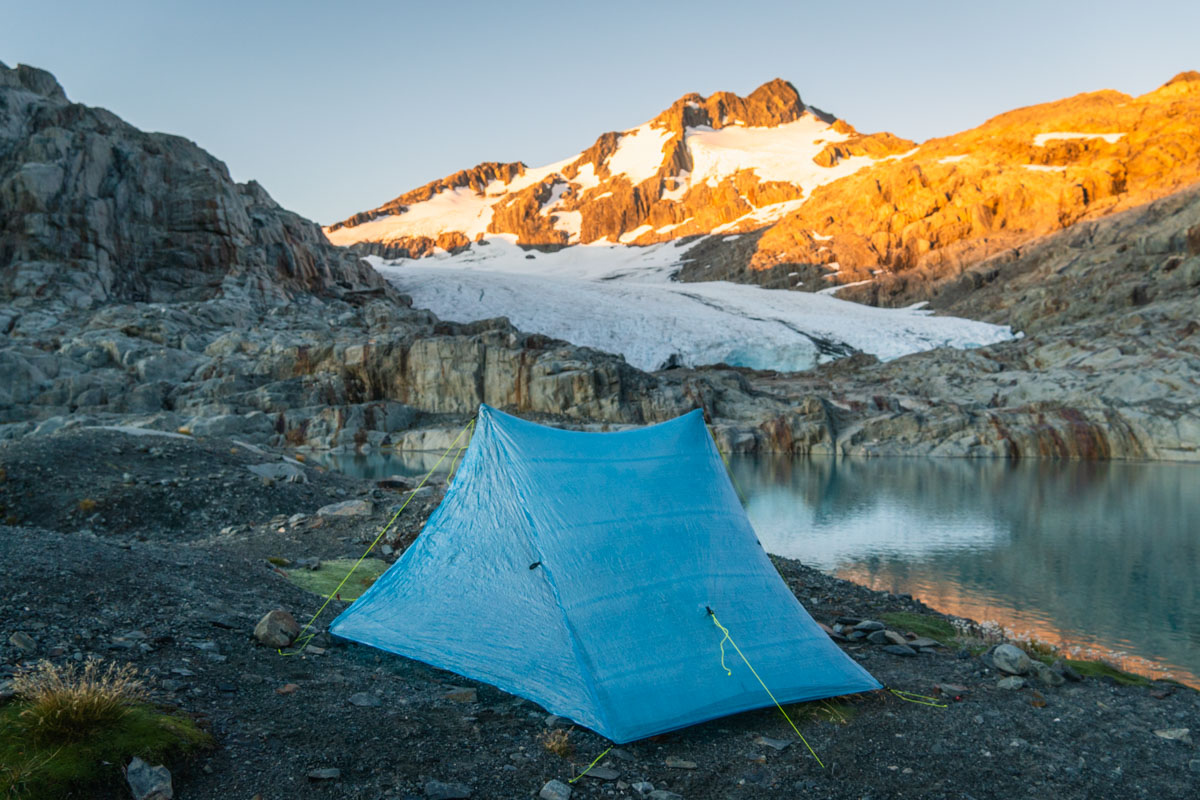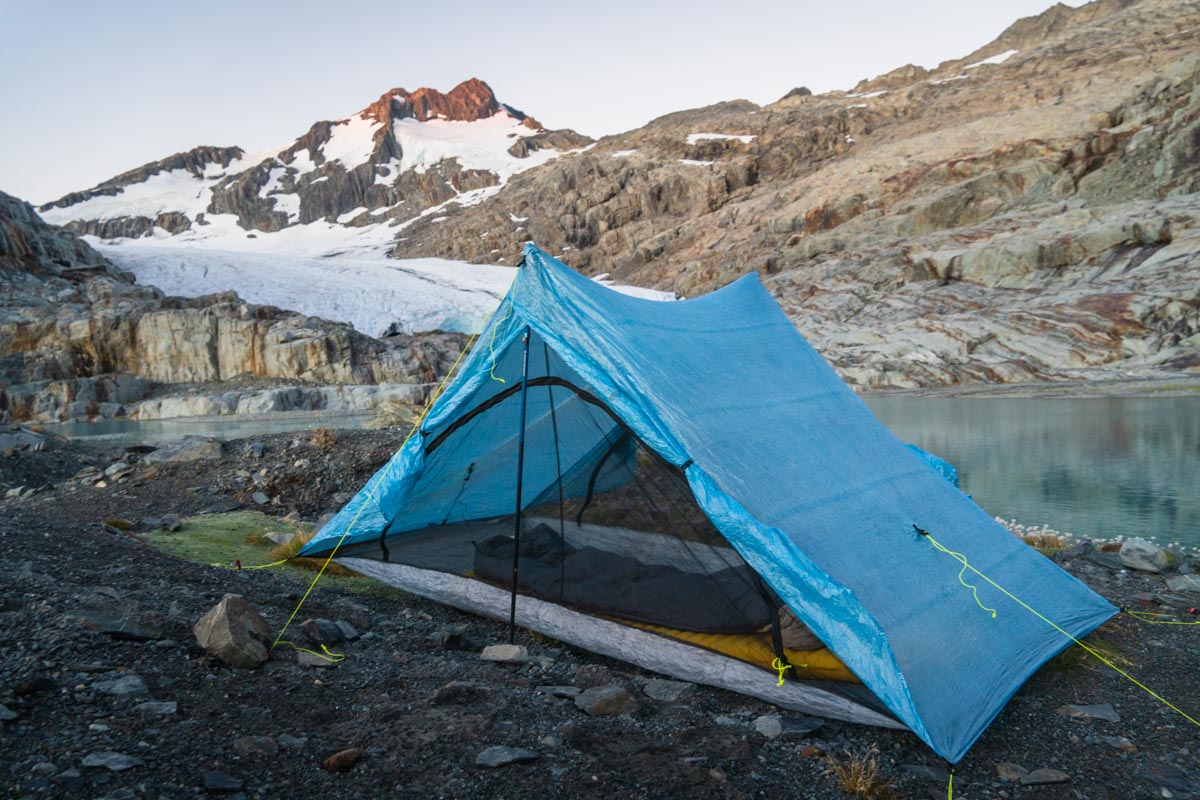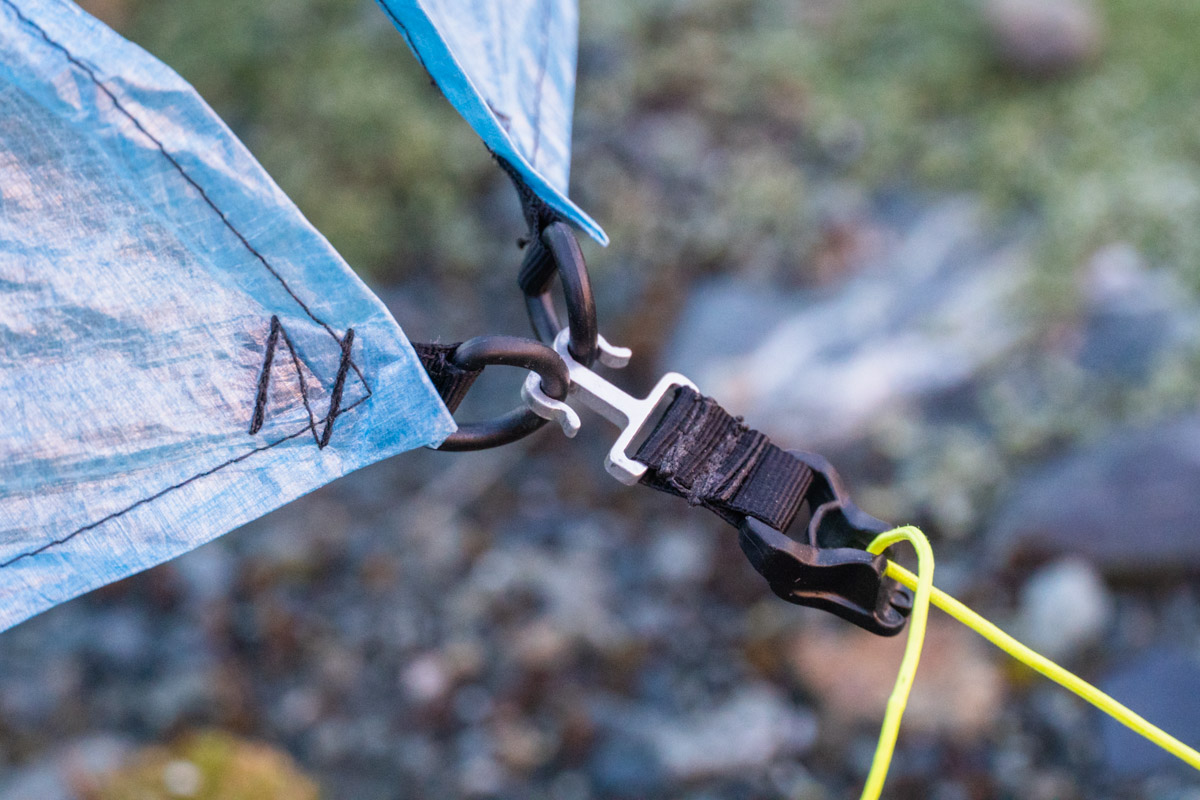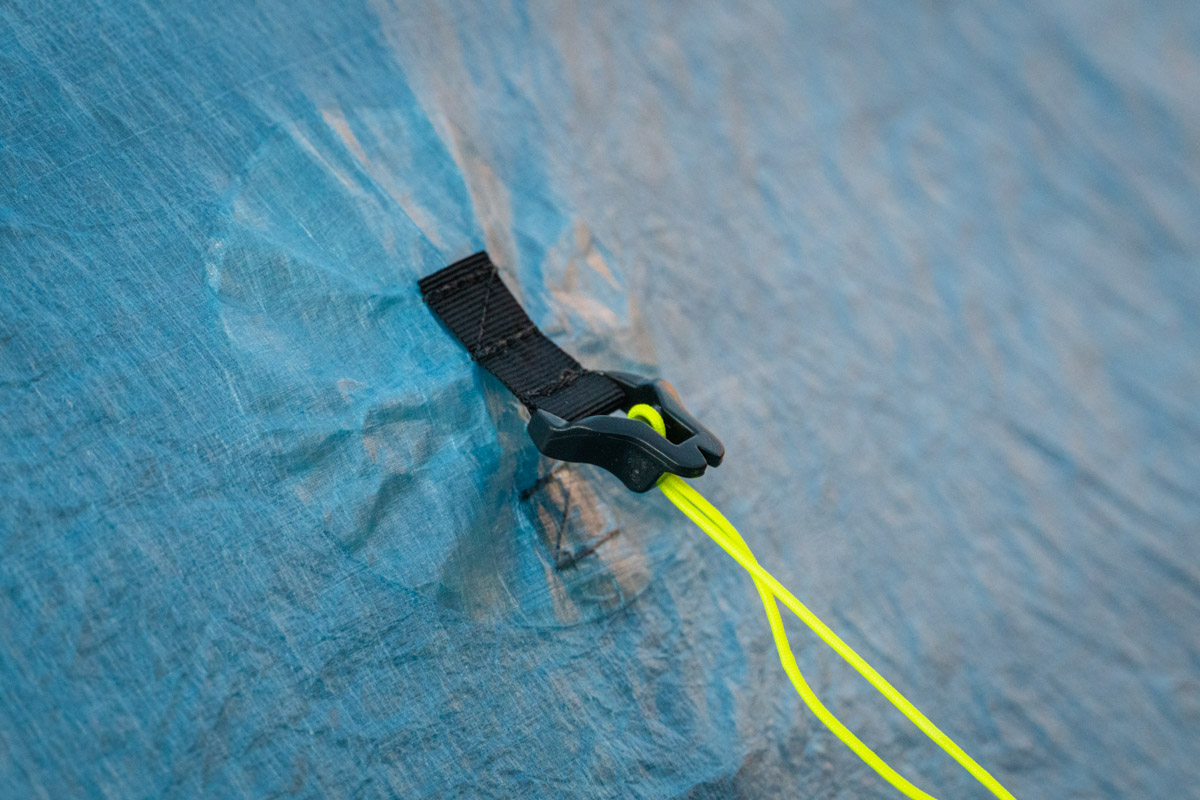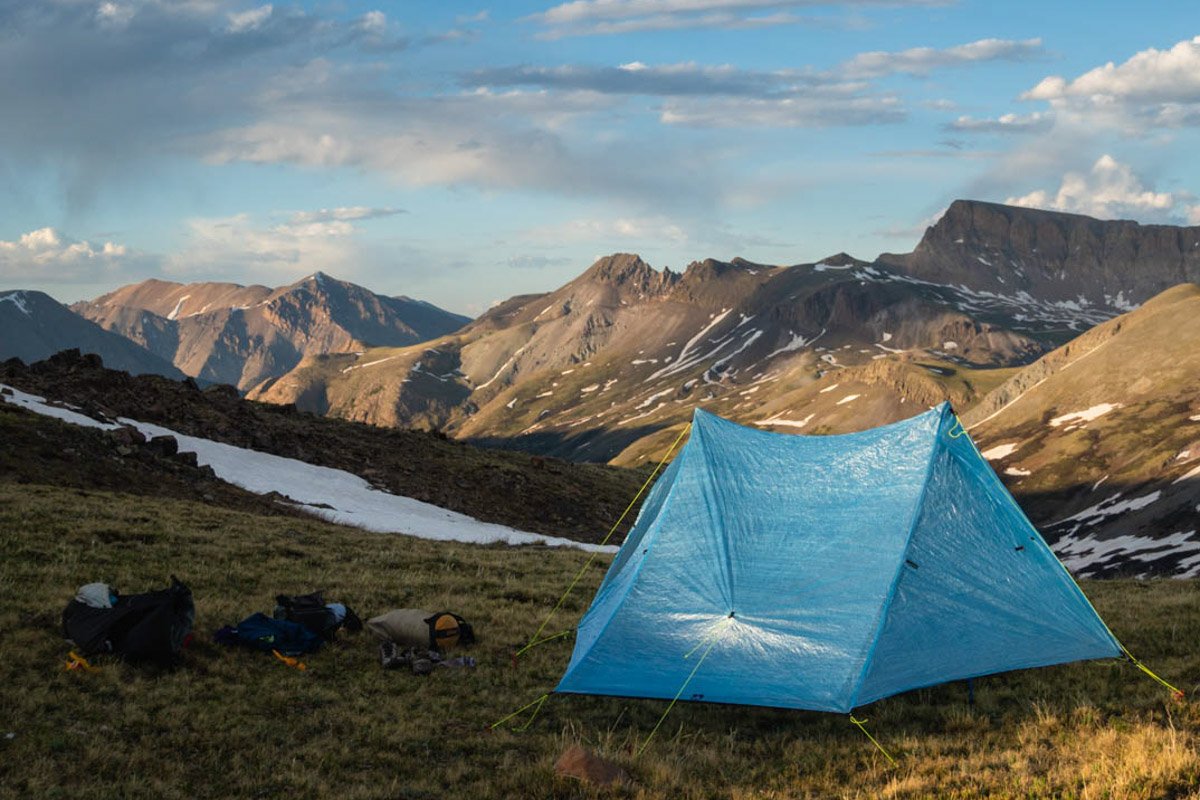The Zpacks Duplex Lite Tent ($670) is a gram-counting fastpacker’s dream shelter, especially if traveling with a partner. Made of waterproof Dyneema Composite Fabric (DCF), the fully enclosed two-person tent, with its stuff sack, has an incredibly light actual weight of 15.9 ounces (450 grams) without stakes. This is lighter than many tarps that don’t offer bug protection. While expensive, this versatile tent excels in nearly any multiday situation. It is light enough to be carried for solo ultralight backpacking trips, and when part of a shared fastpacking kit for two people, it’s lighter than two SOL Escape Bivys.
My main issue with this tent, from a gear-tester point of view, is that it’s so good that I could nearly talk myself out of testing anything else besides this tent when it came to going out on big missions over the past year. I need something light. I need protection against bugs. I want something I can pitch quickly if a storm comes up. The excuses were endless to reach for this shelter over the rest.
Pitched with two trekking poles, there’s no need to carry a dedicated pole set if you already use poles for fastpacking. Like many trekking-pole-supported tents and tarps, this one can be a bit fiddly to pitch at first, but once I worked out the technique, I could get it set up in a matter of minutes. The dual-door and two-vestibule design makes it easy to get in and out without waking your tent mate — or at least without stepping on them — and the vestibules are large enough to store shoes and packs. Zpacks did everything possible to shave weight off this tent, from using 1.3-millimeter guylines to not including internal pockets to hold bits and bobs.
I tested this tent in many climates, from the heat of the Utah desert to the damp forests of New Zealand to the high peaks of Colorado’s San Juan Mountains. I pitched it on various surfaces, including forest loam, alpine tundra, and glacial moraine, and I made it through enough storms that I now trust the setup in all but the worst weather. While this is a single-wall tent, I’ve never had significant issues with condensation, even after a night of rain.
There’s a lot to love about this shelter, and I suspect my relationship with it may become a lifelong love affair. There are many reasons it holds the top spot in our Best Ultralight Tents guide.
Shop the Zpacks Duplex Lite TentZpacks Duplex Lite Tent Pitching
The Zpacks Duplex Lite Tent requires a minimum of six stakes to pitch, and two additional stakes can provide extra stability in bad weather. Four corner stakes set the footprint, two stakes hold out the vestibules and stabilize the two poles, and two additional guylines and stakes can provide additional support on the sides.
Ideally, the tent pitches with 122-centimeter trekking poles, but I’ve used poles as short as 110 centimeters and found that they work fine. In fact, I find that adjustable poles set to 122 centimeters put too much strain on the tiny zippers for my comfort level, so I prefer pitching the tent with my fixed-length 115-centimeter poles.
It’s easy to pitch the tent by laying it out in place, loosely staking the four corner guylines out at 45 degrees to the corners, inserting the two trekking poles, and staking out the vestibules. The corner guylines are a generous 24 inches long (61 centimeters), making it easy to search around for a good piece of dirt to anchor a stake. The guylines are 1.3-millimeter cord, thinner than the normal two-millimeter cord used by many similar tents. The guylines tighten with a clever clip connected to the tent. I found that the guyline could overlap with itself in the clip and jam up, but it was easy to get it moving again and tighten everything down smoothly.
The vestibule doors attach to the guyline on little hooks, and an additional toggle-and-loop closure halfway up the doors minimizes flapping. It can be tricky to get the pitch right so that all four door flaps are taut, and they can make noise flapping in the wind if they’re not.
Zpacks has a detailed guide for setting up the tent that offers trouble-shooting tips if the tent goes up crooked, but I found the best way to work out how to set it up properly was to let it go up wonky and mess with the angles and tightness of the guylines until I worked out what needed tightening or shifting after staking everything out. Once practiced, it’s a surprisingly easy tent to set up.
Two additional guylines on the sides of the tent are good insurance for windy nights and lift the sides of the tent a little bit higher.
Like any trekking-pole-supported tent, properly anchoring the stakes is important, especially in windy conditions. I learned this lesson while sleeping on a glacial moraine, where I deemed stake placement “good enough” and spent the middle of the night re-staking the tent with piles of rocks on the stakes to keep them in place. That said, with the stakes anchored, this tent has withstood some properly windy conditions without showing any sign of collapse.
Zpacks Duplex Lite Tent Weight and Size
I won’t lie; the weight of the Zpacks Duplex Lite Tent is one of the main features that has me reaching for it again and again, especially for trips where I’m trying to keep my pack weight as low as possible but still need a reliable shelter. The tent, with guylines and its stuff sack but without poles or stakes, has an actual weight of 15.9 ounces (450 grams). The DCF stuff sack weighs eight grams, and I tend to bring it along to store the tent during the day and act as a ditty bag for loose pieces of kit in the tent at night. Since I already use poles for my fastpacking adventures, I’d argue that I don’t have to count them as part of this shelter’s weight. If you don’t use poles, you can buy collapsable carbon poles specifically designed for this tent that weigh 2.6 ounces (74 grams) and cost $35 each — and you’ll need two.
When rolled up, the tent is about 4.5 inches in diameter and 11 inches long (11.5 by 28 centimeters), or about 2.9 liters. While the DCF doesn’t compress as small as other materials, I found I could fit the tent in the back mesh pocket of many fastpacking packs.
When set up, the tent has a 90- by 40-inch footprint (230 by 102 centimeters), and the bathtub floor has 6.75-inch (centimeter) walls. You can flatten these walls out to make the tent a bit bigger. While the tent’s footprint accommodates relatively tall people, the sloped walls make the tent functionally smaller if you don’t want your head or feet touching the walls. I’m five feet and six inches tall, and I comfortably fit in the tent with another person without touching the walls, and the peak of the tent, which is 48 inches (122 centimeters), allows two people to sit up at the same time. As far as two-person lightweight tents go, I’ve found the design of this one to optimize space and comfort.
Zpacks Duplex Lite Tent Materials
Made of waterproof and lightweight DCF, the Zpacks Duplex Lite Tent is a stormworthy option when it buckets down rain. Even after a night of rain, the taped seams helped everything stay dry. The design of the storm doors and vestibules keeps airflow through the tent’s interior, minimizing condensation. While I’ve gotten the occasional drop of water on my head from condensation after a damp night, for a single-wall tent, it does really well at staying dry on the inside.
The tent floor features 0.75 ounce per square yard DCF. While I do my best to clear a campsite of debris before setting up a tent, it’s never perfect, and I’ve set this tent up on rocky terrain and not seen any sign of damage to the floor. If you’re worried about tears, you can repair DCF with the aptly named DCF Repair Tape, which Zpacks sells. The bathtub floor keeps moisture from coming in the sides and flooding the floor. The walls feature a slightly lighter 0.55 ounce per square yard DCF that is translucent but still provides enough privacy that you don’t feel like you’re on full display to the outside.
In addition to being fully waterproof, DCF also doesn’t stretch, which means that it won’t start to sag once it gets wet. DCF does seem to hold onto water more than other types of fabrics, so even after shaking it off in the morning after a wet night, it often feels like I can’t get most of the water off and the tent ends up weighing significantly more until I stop to fully dry it in midday sun.
The doors are a thin mesh, and tiny zippers open and close them. I’ve found myself using an abundance of caution when using these zippers, as they are tiny and feel fragile. That said, I’ve used this tent extensively, and the zippers are still as smooth as the first time I used them.
Zpacks Duplex Lite Tent Stormworthiness
The Zpacks Duplex Lite Tent isn’t a four-season tent that I would necessarily turn to in winter blizzard conditions, but for spring, summer, and fall multi-day trips, it’s a solid option. The DCF has an incredibly high tear strength, and the fabric failing is the least of my concerns. While the guylines feel incredibly thin, it’s hard to imagine the wind blowing hard enough to break them, though I should probably knock on wood after writing that. The small plastic hitches used to tighten the guylines and the plastic D-rings holding the tent doors to the guylines seem like the most likely points of failure.
I’ve sat through some wind and rain storms in this tent in fairly exposed locations, and as long as I make sure that the stakes aren’t coming out of the ground — rocks on top of them help keep them in place — I’ve never worried about the tent collapsing in the way that some dedicated-pole free-standing tents with curved poles have.
The tent isn’t quiet in the wind, even when pitched as tautly as I can manage. The toggle-and-hook system that holds the two doors together to form the vestibule isn’t as secure as a zipper would be and inherently lets in a bit of wind and makes some noise when the wind catches the fabric. That said, the more open design allows the setup to breathe and minimizes condensation. Plus, it’s lighter than a zipper and more durable, especially in sandy desert conditions.
Zpacks Duplex Lite Tent Overall Impressions
As a self-identifying gram-counting fastpacker who wants to have gear that will work in as many situations as possible, the versatility of the Zpacks Duplex Lite Tent drew me in. Whether I’m fastpacking solo or with a partner, the two-person tent is light enough to carry by myself if I haven’t been able to talk anyone into one of my dumb ideas and easily makes a case for itself over a dual-bivy setup when I’ve convinced someone to come romping in the mountains with me. With two people, it’s reasonably comfortable with two doors and vestibules; alone, it’s a castle of high-tech, lightweight, waterproof fabric. For warmer nights, it’s easy to sleep with one or more of the doors open for airflow, and it all buttons up tight for cold or windy nights.
Is this tent worth the price tag? I’d argue that for someone who wants to move light and fast over all types of terrain and have a single tent that will work for nearly any fastpacking situation, it’s a worthy investment. Made of durable — and repairable — materials, this tent seems like it will last a long time and provide as many nights of protection and adventure as you can throw at it.
Shop the Zpacks Duplex Lite TentCall for Comments
- If you’ve used it, what are your thoughts on the Zpacks Duplex Lite Tent?
- Do you have another favorite ultralight tent?
Our Favorite Ultralight Tents
Check out our best ultralight tents guide for our current favorite shelters for fastpacking.
